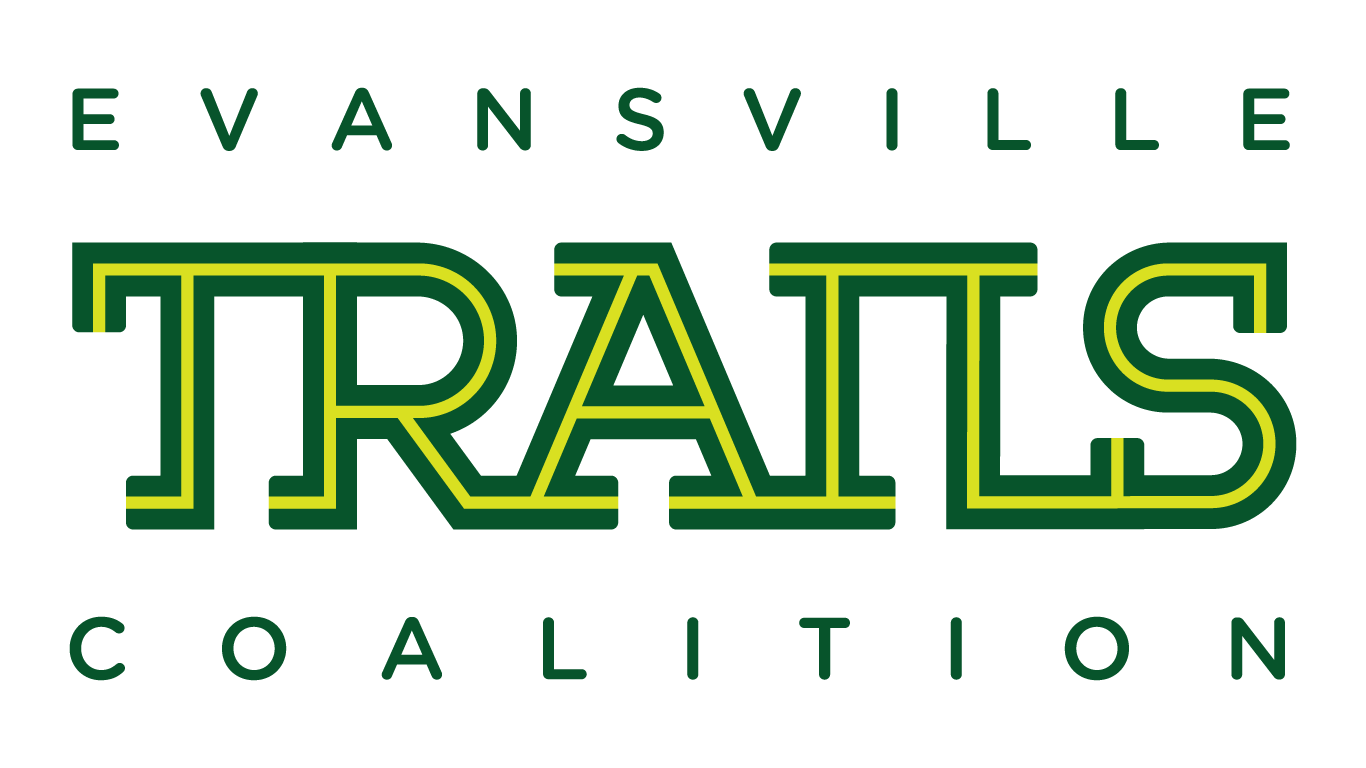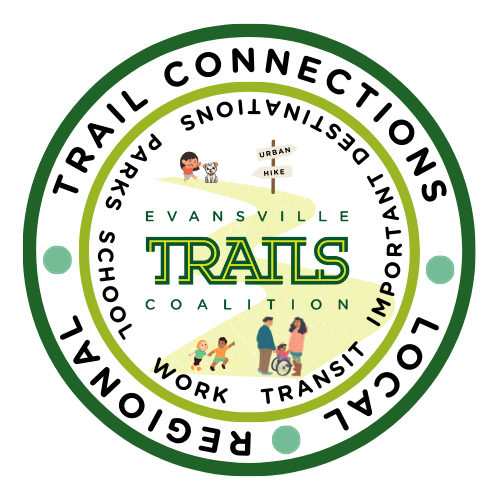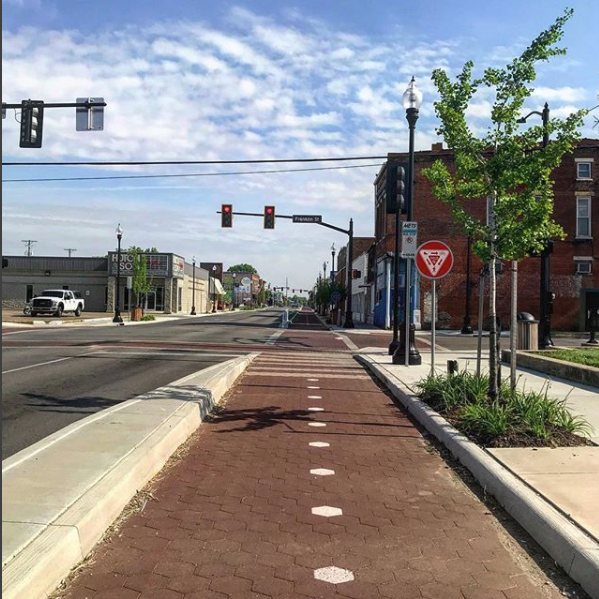About Trails
TRAILS ARE NONMOTORIZED SUPER-HIGHWAYS
Trails provide Hoosiers with a place to recreate and exercise. Trails also connect neighborhoods to parks, natural areas, sports fields, and community resources. Increased physical activity reduces the chances of heart disease, cancer, and obesity, and contributes to healthy living. Trails provide a way for communities to reduce vehicle congestion and emissions, decrease commuter and road maintenance costs and increase road safety. Added benefits are infrastructure corridor connectivity and improvements, all while advancing positive economic impact that trail use brings by increasing commerce, creating jobs, increasing property values, and providing important low-cost community health, over-all wellness/wellbeing and recreation opportunities to all ages!
Pigeon Creek Greenway, Riverfront Segment
Hi-Rail Segment, along Hwy 41 from Walnut St. to Riverside Dr.
Industrial Corridor Segment
North Main Street Segment
TRAILS HELP TO SUPPORT, INCREASE, ATTRACT, CONNECT AND FACILITATE COMMUNITY PROGRESS
Why Trails? Trails support many forms of exercise and recreation, improve health, provide transportation alternatives, and reduce emissions pollution. Trails facilitate community walking, running, and bicycling—why do walking, running, and bicycling matter in a community? Because they are the lowest cost form of transportation and are non-polluting, energy-efficient, and healthy.
Statistically, trails also create economic vitality in the towns, cities, and neighborhoods through which they are built and trails increase the value of properties within the trail vicinity. Every dollar spent building multi-use trails returns a multiple of that annually. Trails attract thousands of users and have immediate success when built. Local and out of town Trailblazers add significantly to the economy. Also, trails connect our neighborhoods to each other, to schools, parks, and each area of our city and county. Walkable, bikeable communities are communities of choice—communities that have trails are more desirable and community members are overwhelmingly positive about trails and the quality of life improvements trails facilitate.
How are trails built and where does the money come from?
Traditionally, trail development in Indiana has been paid for through a combination of federal and state funds, with local matching dollars coming from public and private sources.
In Indiana, state and private funds for trails have been secured and directed toward trails since 2006. Substantial amounts of American Recovery and Reinvestment Act special federal stimulus Transportation Enhancement funding were made available for trails in Indiana (see additional information HERE).
Generally, trail projects have three major stages to the building process with many steps within each stage.
Cost to plan - includes the complete scope of the project, such as land acquisition, environmental considerations, permits, licenses, amenities, and the trail design.
Cost to build - all aspects and phases of materials to complete the physical built trail, including fuel, equipment, asphalt, stone, gravel, labor.
Cost to maintain - upkeep, repairs; city management, maintenance crews, contractors, service groups, volunteers, adopt-a-trail program, etc.
As a rule of thumb, funding for trail construction is reliant on funding options and availability, from private grants to city, state, and federal government funding. State and federal funding and grant sources often follow the 80-20 model, which requires the city to match 20% of whatever amount is given by the state or federal total project funding:
Trails facilitate multiple modes of active transportation and support the transformation of how we travel in America. Benefits are far-reaching and bring powerful outcomes to every type of community, including connecting people to places in and around their neighborhoods, their place of employment, and other opportunities. Trails create opportunities for people to be physically active and outdoors, revitalizing economies and the very communities where people live, work, go to school, and play.
Urban Trails
Urban trails may be comprised of many different materials connection districts, neighborhoods, and important locations within; urban trails can have the greatest impact on a community if the system of urban trails is connected. This increases the opportunities for those seeking to use trails for recreation, physical activity, and for transportation and has the highest potential for overall success in a community’s desire to become multimodal. See information regarding the benefits of urban trails by American Trails Urban Trails *An Urban trail creates an active transportation corridor through a built environment—urban trails are a network of non-motorized, connected multi-use pathways that are used by walkers, runners, bicyclists, skaters, and other human-powered modes of activities, for health, transportation, and recreational purposes. Active transportation refers to human-powered methods of travel, such as walking, bicycling, or rolling to get from one place to another. Multi-use trails have many aesthetic design differences, but essentially have standardized codes determined by Federal, State and Local City and County governments, so trails are built to a standard. Urban trails are developed to accommodate all people with varying levels of ability, such as younger and older people, as well as being accessible to people with disabilities.
What are the benefits of Active Transportation?
Safe places to walk, bike, or travel by other human-powered means
Improves access to transit and provides alternative modes of vehicle travel
Reduces transportation costs and supports the local economy
Reduces greenhouse gas emissions and traffic congestion
Provides opportunities for physical activity and improves public health
Trail Standards
Trails design, development, and construction processes are determined primarily through national and state resources for trail standards and design guidelines. This may include, but is not limited to, the Indiana Department of Transportation, *the American Association of State Highway and Transportation Officials (AASHTO), the National Association of City Transportation Officials (NACTO), the Federal Highway Administration (FHWA), and the Institute of Transportation Engineers (ITE). These standards consider all the recommendations set forth by these entities and support the use of these resources for trail standards and design guidelines.
*Urban trails are public paths that provide corridors through an urban environment and allow people to get from one place to another on foot, by bicycle, on roller skates or skateboards, with strollers or in wheelchairs, without feeling any threat from nearby motor vehicles.
*Source: Americantrails.org; AustinTexas.gov; AmericanPlanningOrganization
Additional information:
See information regarding the creation of nature trails in the United States by the National Park Service: Creation of Trails
Complete Streets
Complete Streets are streets for everyone. They are designed and operated to enable safe access for all users, including pedestrians, bicyclists, motorists, and transit riders of all ages and abilities. Complete Streets make it easy to cross the street, walk to shops, and bicycle to work. They allow buses to run on time and make it safe for people to walk to and from train stations.
Creating Complete Streets means transportation agencies must change their approach to community roads. By adopting a Complete Streets policy, communities direct their transportation planners and engineers to routinely design and operate the entire right of way to enable safe access for all users, regardless of age, ability, or mode of transportation. This means that every transportation project will make the street network better and safer for drivers, transit users, pedestrians, and bicyclists—making your town a better place to live. See more at: What are Complete Streets
Nature Trails
Urban Nature trails and Multi-use Trails serve different users, but are both very important to a community and its residents.
Urban nature trails and multi-use trails differ in purpose, design, and use:
Urban Nature Trails: These are typically unpaved or minimally developed paths designed to immerse users in natural settings within or near urban areas. They prioritize conservation, recreation, and environmental education, allowing users to experience local ecosystems, flora, and fauna. Activities like walking, hiking, or birdwatching are common on these trails, often with restrictions to preserve the surrounding environment.
Multi-Use Trails: These are versatile, paved or gravel paths designed for a broader range of activities, including walking, biking, running, and sometimes skating or wheelchair use. They prioritize connectivity, providing safe and accessible routes for recreation and transportation between neighborhoods, parks, schools, and other community hubs.
In essence, urban nature trails focus on preserving and enjoying natural spaces, while multi-use trails emphasize functionality and accessibility for diverse users.
Within a community, trails and complete streets support quality of life, increase economic growth and serve to provide a means to benefit the health of members of the community. See the 2017 Indiana Trails Study Summary Report by the Indiana University, Eppley Institute for Parks and Public Lands. Click Here to access the report.






